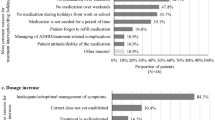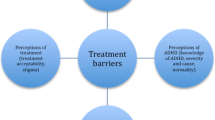Abstract
Although stimulant medication can reduce symptoms and lessen the degree of functional impairment associated with attention deficit hyperactivity disorder (ADHD), the adherence rate in adults diagnosed with ADHD is reportedly <12 %. The article explores the contexts that influence stimulant medication adherence in adults diagnosed with ADHD. Using a mixed-method design, data on ADHD-related quality of life and stimulant adherence were collected from 67 adults with ADHD. Next, 18 of those adults, based on adherence/quality of life, completed semi-structured interviews. Qualitative data were analyzed using thematic narrative inquiry, based on the Health Belief Model. Findings revealed no direct relation between stimulant adherence and quality of life. Instead, the doctor/patient relationship was a strong predictor of a person’s quality of life. Physicians treating adults with ADHD must be aware of individual variation in stimulant response, seek to understand the functional limitations of their patients and strive to communicate effectively.

Similar content being viewed by others
References
Able S, Johnston J, Adler L, Swindle R (2007) Functional and psychosocial impairment in adults with undiagnosed ADHD. Psychol Med 37:97–107
Adler L, Spencer T, Williams D, Moore R, Michelson D (2008) Long-term, open-label safety and efficacy of atomoxetine in adults with ADHD: final report of a 4-year study. J Atten Disord 12:248–253
Agarwal R, Goldenberg M, Perry R, Ishak W (2012) The quality of life of adults with attention deficit hyperactivity disorder: a systematic review. Innov Clin Neurosci 9:10–21
Aikens J, Nease D, Klinkman M (2008) Explaining patients’ beliefs about the necessity and harmfulness of antidepressants. Ann Fam Med 6:23–29
Barkley R, Murphy K, Fischer M (2008) ADHD in adults: what the science says. The Guilford Press, New York
Berger B, Felkey B (2001) Improving patient compliance. impact U.S. pharmacist continuing education series June 1–12 U.S. Pharmacist, Bridgewater, NJ
Biederman J, Mick E, Fried R, Aleardi M, Potter A, Herzig K (2005) A simulated workplace experience for non-medicated adults with and without ADHD. Psychiatry Serv 56:1617–1620
Biederman J, Faraone S, Spencer T, Mick E, Monuteaux M, Aleardi M (2006) Functional impairments in adults with self-reports of diagnosed ADHD: a controlled study of 1001 adults in the community. J Clin Psychiatry 67:524–540
Biederman J, Mick E, Surman C, Doyle R, Hammerness P, Michel E, Martin J, Spencer T (2007) Comparative acute efficacy and tolerability of OROS and immediate release formulations of methyphenidae in the treatment of adults with attention-deficit/hyperactivity disorder. BMC Psychiatry 7:49–57
Braun V, Clarke V (2006) Using thematic analysis in psychology. Qual Res Psychol 3:77–101
Brod M, Perwien A, Adler L, Spencer T, Johnston J (2005) Conceptualization and assessment of quality of life for adults with attention-deficit/hyperactivity disorder. Prim Psychiatry 12:58–64
Brod M, Johnston J, Able S, Swindle R (2006) Validation of the adult attention-deficit/hyperactivity disorder quality-of-life scale: a disease-specific quality-of-life measure. Qual Life Res 15:117–129
Brunt K, Matza L, Classi P, Johnston J (2011) Preference related to attention-deficit/hyperactivity disorder and its treatment. Patient Prefer Adherence 5:33–43
Charach A, Fernandez R (2013) Enhancing ADHD medication adherence: challenges and opportunities. Curr Psychiatry Rep. doi:10.1007/s11920-013-0371-6
Crabtree B, Miller W (1999) A template approach to text analysis: developing and using codebooks. In: Crabtree B, Miller W (eds) Doing qualitative research. Sage Publishing, Thousand Oaks, pp 163–177
Cramer J (1991) Overview of methods to measure and enhance patient compliance. In: Cramer J, Spilker B (eds) Patient compliance in medical practice and clinical trials. Raven Press, New York, pp 3–10
Crawford P, Gilbert P, Gilbert J, Gale C, Harvey K (2013) The language of compassion in acute mental health care. Qual Health Res 23:719–727
Curtis F, Fairman K (2007) ADD or ADHD or what exactly?—GIGO part II and other lessons in research with administrative claims. J Manag Care Pharm 13:617–619
Escobar R, Schacht A, Wehmeier P, Wagner T (2010) Quality of life and attention-deficit/hyperactivity disorder core symptoms: a pooled analysis of 5 non-US atomoxetine clinical trials. J Clin Psychopharmacol 30:145–151
Faraone S, Biederman J, Mick E (2006) The age-dependent decline of attention deficit hyperactivity disorder: a meta-analysis of follow-up studies. Psychol Med 36:159–165
Fereday J, Muir-Cochrane E (2006) Demonstrating rigor using thematic analysis: a hybrid approach of inductive and deductive coding and theme development. Int J Qual Methods 5. http://ejournals.library.ualberta.ca/index.php/IJQM/article/view/4411. Accessed 11 January 2013
Findling R, Connor D, Wigal T, Eagan C (2009) A linguistic analysis of in-office dialogue among psychiatrists, parents, and child and adolescent patients with ADHD. J Atten Disord 13:78–86
Fleischmann A, Fleischmann R (2012) Advantage of an ADHD diagnosis in adulthood: evidence from online narratives. Qual Health Res 22:1486–1496
Glanz K, Rimer B (2005) Theory at a glance: a guide for health promotion practice. National Cancer Institute, National Institutes of Health, 2nd edn. U.S. Department of Health and Human Services, Washington, DC
Gudjonsson G, Sigurdsson J, Eyjolfsdottir G, Smair J, Young S (2009) The relationship between satisfaction with life, ADHD symptoms, and associated problems among university students. J Atten Disord 12:507–515
Hodgkins P, Boken M, Capone N, Deleon A (2006) Office visits and prescription fill rates in patients with ADHD. U.S. Psychiatric and Mental Health Congress, Abstract 122, November 2006, New Orleans, Louisiana
Horne R, Weinman J (1999) Patients’ beliefs about prescribed medicines and their role in adherence to treatment in chronic physical illness. J Psychosom Res 27:555–567
Horne R, Weinman J, Hankins M (1999) The beliefs about medicines questionnaire: the development and evaluation of a new method for assessing the cognitive representation of medication. Psychol Health 14:1–24
Ivankova N, Creswell J, Stick S (2006) Using mixed-methods sequential explanatory design: from theory to practice. Field Methods 18:3–20
Jadad A, Boyle M, Cunningham C, Kim M, Schachar R (1999) Treatment of attention-deficit/hyperactivity disorder. Evidence Report/Technology Assessment No. 11 Prepared by McMaster University under Contract No. 290-97-0017 AHRQ Publication No. 00-E005 Agency for Healthcare Research and Quality, Rockville, MD
Janz N, Becker M (1984) The health belief model: a decade later. Health Educ Q 11:1–47
Jonsdottir H, Friis S, Horne R, Pettersen K, Reikvam A (2009) Beliefs about medications: measurement and relationship to adherence in patients with severe mental disorders. Acta Psychiatr Scand 119:78–84
Kessler R, Adler L, Barkley R, Biederman J, Conners K, Demler O, Faraone S, Greenhill L, Howes M, Secnik K, Spencer T, Ustun T, Walters E, Zaslavsky A (2006) The prevalence and correlates of adult ADHD in the United States: results from the national comorbidity survey replication. Am J Psychiatr 163:716–723
Kramer J, Hammill B, Anstrom K, Fetteroff D, Snyder R, Charde J, Hoffman B, LaPointe N, Peterson E (2006) National evaluation of adherence to (Beta) blocker therapy for 1 year after acute myocardial infarction in patients with commercial health insurance. Am Heart J 152:454.e1–454.e8
Lowen B, Rosen J, Marttila J (2011) An agenda for improving compassionate care: a survey shows about half of patients say such care is missing. Health Aff 30:1772–1778
Matza L, Johnston J, Faries D, Malley K, Brod M (2007) Responsiveness of the adult attention-deficit/hyperactivity disorder quality of life scale (AAQoL). Qual Life Res 16:1511–1520
Montoya A, Quail D, Anand E, Cardo E, Alda J, Escobar R (2013) Prognostic factors of improvement in health-related quality of life in atomoxetine-treated children and adolescents with attention-deficit/hyperactivity disorder, based on a pooled analysis. Atten Defic Hyperact Disord. doi:10.1007/s12402-013-0119-5
Morris L, Schulz R (1992) Patient compliance: an overview. J Clin Pharm Ther 17:183–195
Munro S, Lewin S, Swart T, Volmink J (2007) A review of health behavior theories: how useful are these for developing interventions to promote long-term medication adherence for TB and HIV/AIDS? BMC Public Health 7:1–16
Olfson M, Marcus S, Zhang H, Wan G (2007) Continuity in methylphenidate treatment of adults with attention-deficit/hyperactivity disorder. J Manag Care Pharm 13:570–577
Osterberg L, Blaschke T (2005) Adherence to medication. N Engl J Med 353:487–497
Perwien A, Hall J, Swensen A, Swindle R (2004) Stimulant treatment patterns and compliance in children and adults with newly treated ADHD. J Manag Care Pharm 10:122–129
Pope C, Ziebland S, Mays N (2000) Qualitative research in health care: analyzing qualitative data. Br Med J 320:114–116
Rafalovich A (2005) Exploring clinician uncertainty in the diagnosis and treatment of attention deficit hyperactivity disorder. Sociol Health Illn 27:305–323
Ramsay J, Rostain A (2008) Adult ADHD research: current status and future directions. J Atten Disord 11:624–627
Roberson M (1992) The meaning of compliance: patient perspectives. Qual Health Res 2:7–26
Rostain A, Ramsey J (2006) A combined treatment approach for adults with ADHD—results of an open study of 43 patients. J Atten Disord 10:150–159
Safren S, Duran P, Yovel I, Perlman C, Sprich S (2007) Medication adherence in psychopharmacologically treated adults with ADHD. J Atten Disord 10:257–260
Serradell J, Litman T, Hendel D, Hadsall R (1990) Patients’ perception in provision of information and drug defaulting behavior. Pharmacy 1:35–46
Stern A, Pollak Y, Bonne O, Malik E, Maeir A (2013) The relationship between executive functions and quality of life in adults with ADHD. J Atten Disord. doi:10.1177/1087054713504133
Torgersen R, Gjervan B, Rasmussen K (2008) Treatment of adult ADHD: is current knowledge useful to clinicians? Neuropsychiatr Dis Treat 4:177–186
Vermeire E, Hearnshaw H, Van Royen P (2001) Patient adherence to treatment: three decades of research. A comprehensive review. J Clin Pharm 26:331–342
Weisler R, Goodman D (2007) Understanding adult ADHD: treatment adherence and rationale for treatment selection. Psychiatric Times Reporter, pp 2–5
Weisler R, Biederman J, Spencer T, Wilens T, Faraone S, Chrisman A, Read S, Tulloch S (2006) Mixed amphetamine salts extended-release in the treatment of adult ADHD: a randomized, controlled trial. CNS Spectr 11:625–639
Weiss M, Hechtman L, Weiss G (1999) AD/HD in adulthood. Johns Hopkins University Press, Baltimore
Weiss M, Gadow K, Wasdell M (2006) Effectiveness outcomes in attention-deficit/hyperactivity disorder. J Clin Psychiatry 67:38–45
Author information
Authors and Affiliations
Corresponding author
Rights and permissions
About this article
Cite this article
O’Callaghan, P. Adherence to stimulants in adult ADHD. ADHD Atten Def Hyp Disord 6, 111–120 (2014). https://doi.org/10.1007/s12402-014-0129-y
Received:
Accepted:
Published:
Issue Date:
DOI: https://doi.org/10.1007/s12402-014-0129-y




